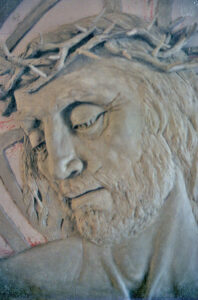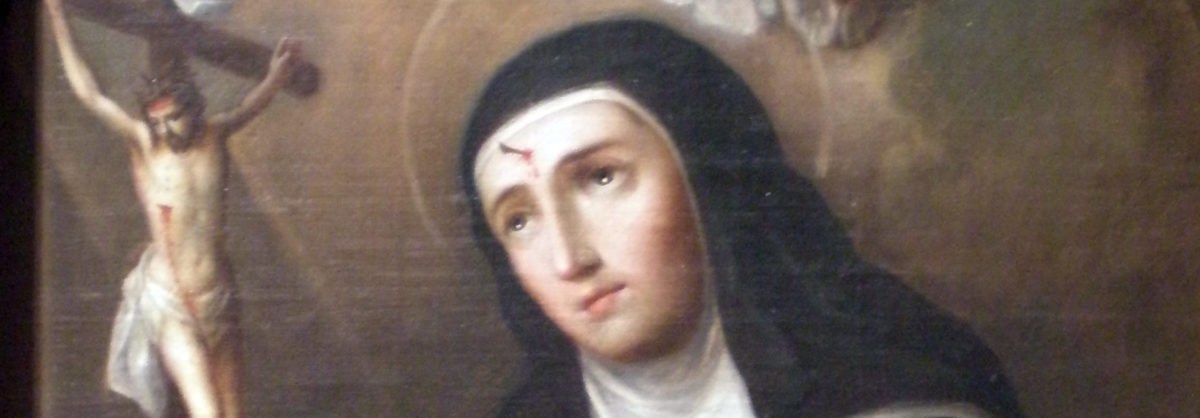The image of the Resurgent Christ (Jesus of Holy Saturday) depicts an apparently vulnerable Christ emerging from slumber. His eyes are half-open, his head turned to the side, and his pierced hands crossed gently over his lap. Yet the heart of the moment depicted is not weakness or defeat, but victory. It is an image of the very moment Christ awakens from the sleep of death thus definitively destroying the power of Satan once and for all. 
The Resurgent Christ is an image of victorious hope after egregious suffering that appears to have the final word. This image and what it symbolizes play significant roles in St. Rita of Cascia’s story of sainthood.
Like St. Elizabeth Ann Seton, Rita was a wife and mother who lost both a husband and children. Christ’s redemptive power was exemplified in these two witnesses when God invited them as tragedy-stricken widows to religious vocations for the sake of his kingdom. Ultimately, both women reached sainthood through God’s providential hand in their vocations as wives, mothers, and religious sisters.
Rita was born in a small village called Roccaporena to well-respected parents known for being peacemakers. Growing up around Augustinian sisters, she was drawn to their way of life, but she obeyed her parents when they arranged for her marriage to Paolo Mancini. The couple had two sons, but while the boys were still young, Paolo was murdered as the result of a feud between his family and another. The custom was that sons should avenge a father’s deaths in such cases, but Rita convinced her sons to forgive their father’s murderer instead, ending the cycle of violence.
However, within a year, both sons died of a deadly illness, leaving Rita a childless widow. She accepted these sufferings, placing her trust in the Lord and surrendering her children and husband to Him.
Soon, Rita’s attraction to Augustinian religious life returned. Rita made her desires known to the sisters, but they were hesitant because of the family vendetta that led to her husband’s death. There were members of the opposing family in the convent, and the sisters feared that Rita’s presence there would stir up trouble.
Rather than accepting this conflict as a permanent limit in her life, Rita again undertook the task of peacemaking and implored her husband’s family to reconcile with their enemies. Inspired by Rita’s boldness, they agreed, and the families documented the end of their feud in writing. Rita then entered the Augustinian convent and lived by the Rule of St. Augustine, with prayer, contemplation, and spiritual reading.
This daily rhythm led to a quiet deepening of Rita’s intimacy with Christ, which manifested itself on Good Friday in 1442. Before the image of Jesus of Holy Saturday, she became deeply aware of the sufferings Christ took upon Himself for the sake of humanity. Having already experienced significant suffering in her own life, Rita, out of love for Christ, spoke her desire to share in more of His sufferings in order that she may alleviate it, even a small amount. She received a thorn from Christ’s crown piercing her forehead and was intimately united to him in his suffering until her death fifteen years later.
The joys and sufferings of her previous vocation as a wife and mother were not forgotten, however. As Rita was dying, she asked a relative for a rose from her family’s garden. The relative was disheartened, as it was winter and the gardens were bare. However, when she went to the family home, a single rose was growing miraculously in the snow. When she brought it to Rita, Rita joyfully interpreted it as a sign from God that He had heard her prayers and redeemed her husband and sons in their tragic deaths. She was comforted to believe that God would welcome them to eternal life with Him.
While Mother Seton did not have a miraculous physical manifestation of Christ’s union with her as Rita did, she reported that in her contemplations, it was as if she were “living in Christ’s wounds.”
St. Rita of Cascia and St. Elizabeth Ann Seton show us that living within Christ’s wounds brings peace in the face of tragedy. Their lives, and the lives of all the saints, point us back to Christ’s final victory in His Cross and His empty tomb, encouraging us to place our hope in the promises of God, to follow His commands with confidence, and to trust in His providence.
Christina O’Brien is a writer, teacher and performing artist from Washington, D.C. She is a monthly contributor for the Young Catholic Woman and she co-hosts a podcast called “A Place Within.”
Image: Saint Rita 18th century, National Museum of Art, Mexico City
This reflection was previously published. To view all of our Seton Reflections, click here.
